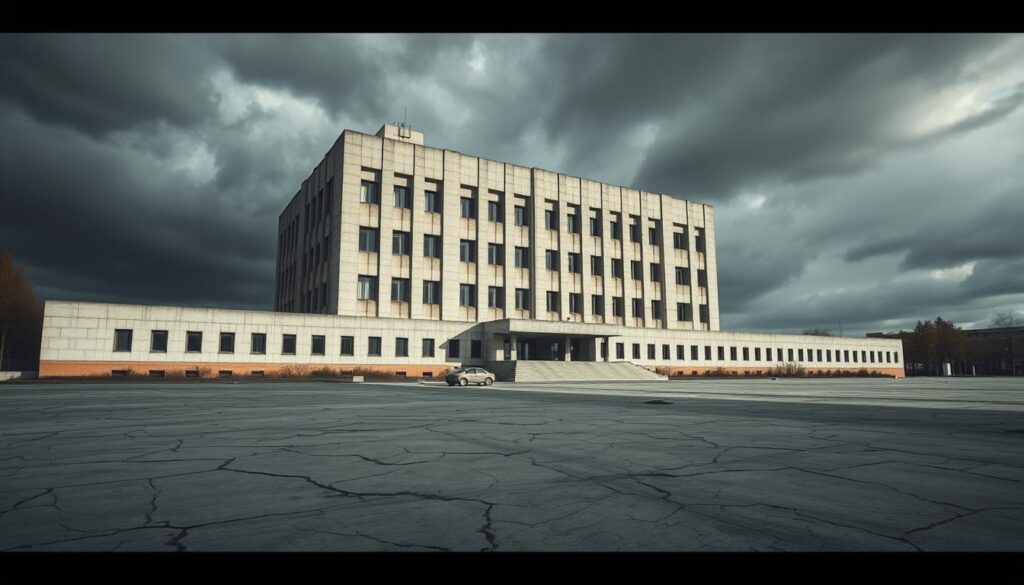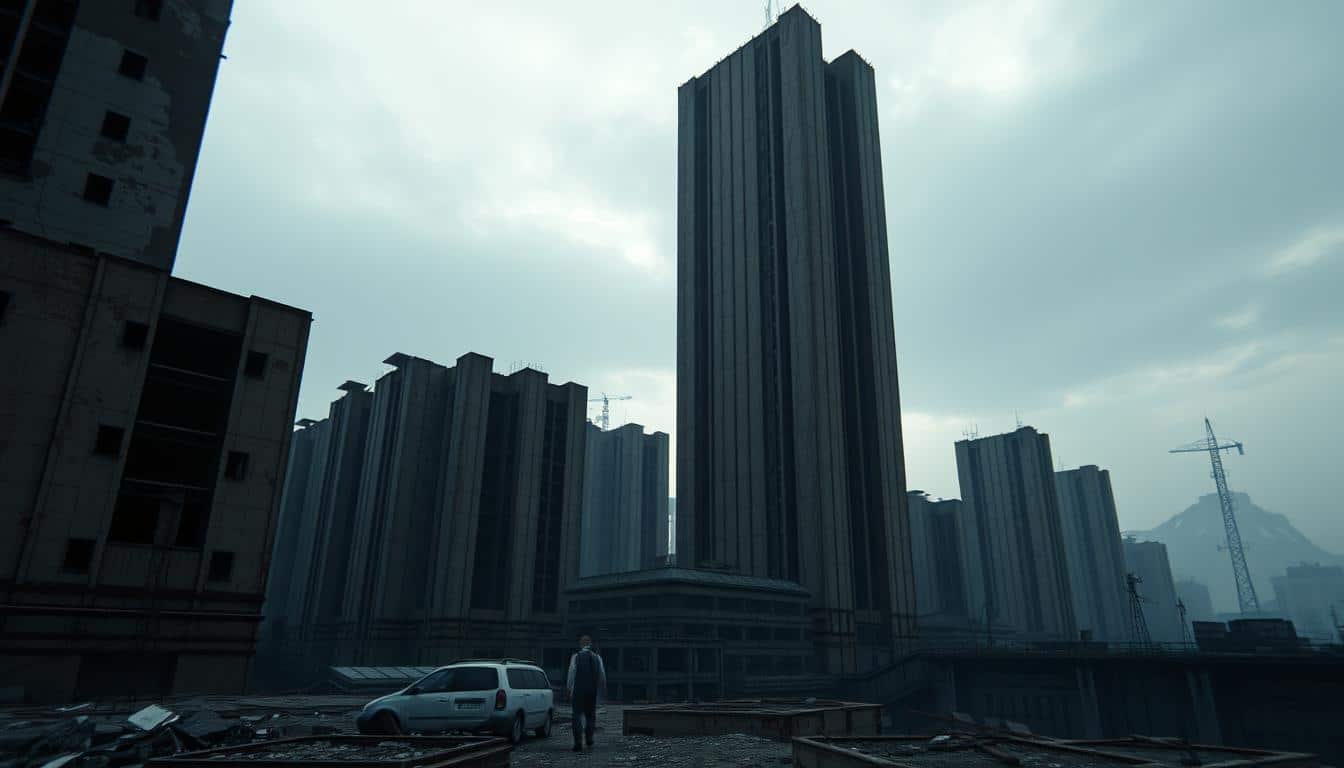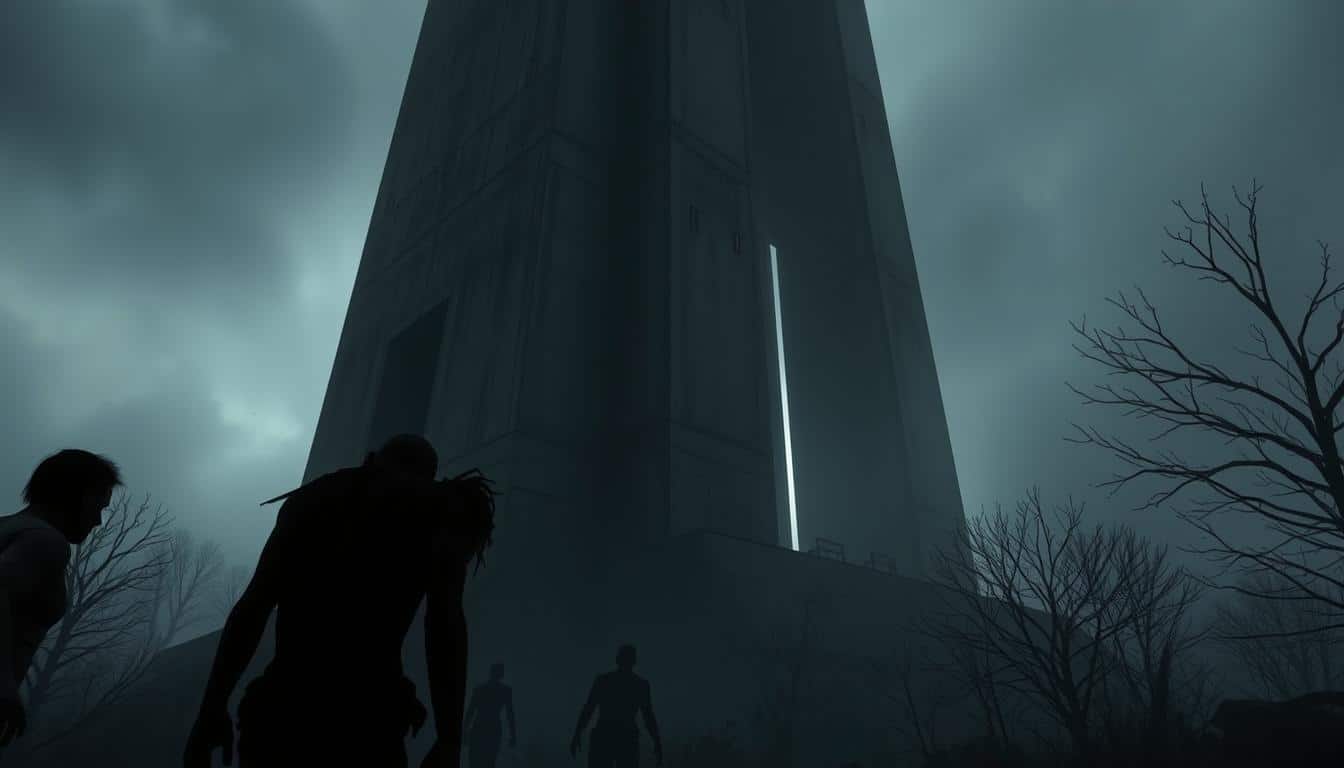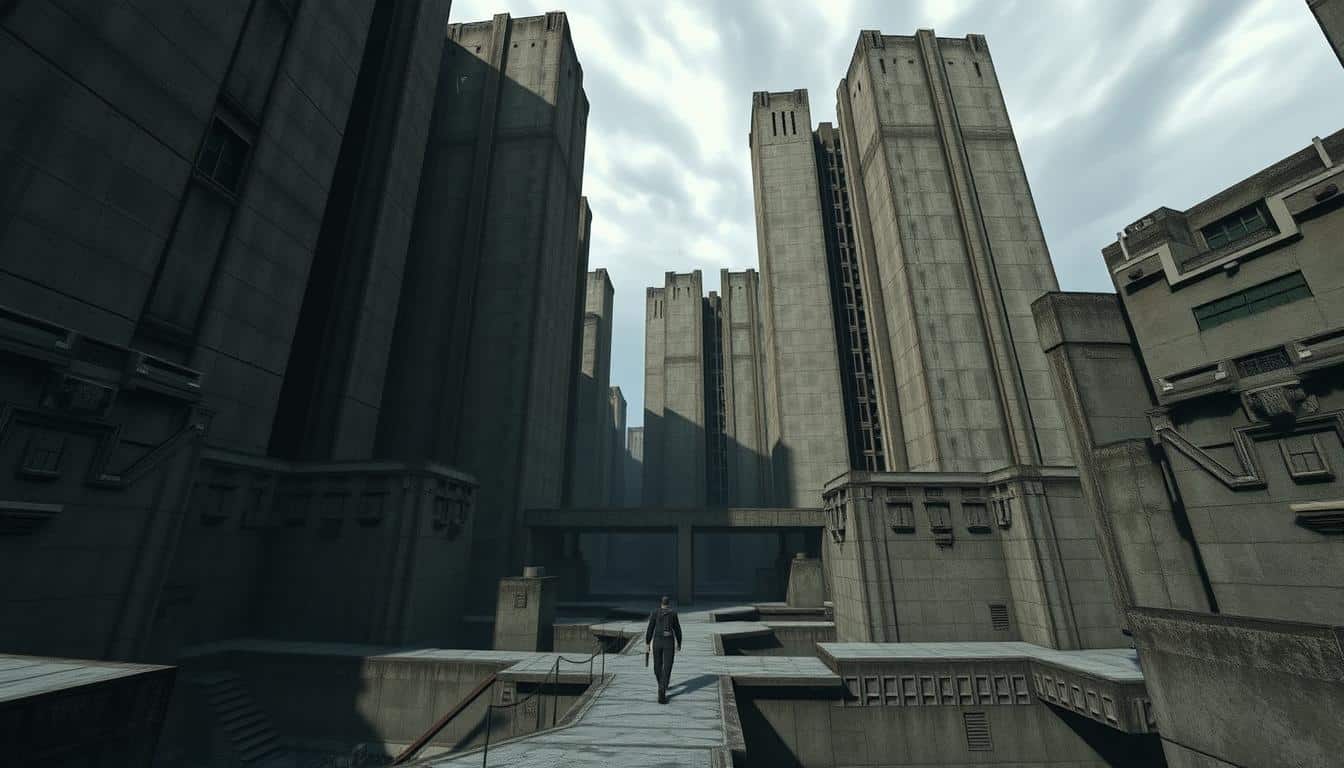Soviet brutalism is more than just an architectural style. It brings a feeling of starkness and grandeur. Its marks are seen way beyond its buildings. In horror games, this style influences the look and the game’s mood. The coldness of Soviet brutalism makes the game scarier and more tense. This piece looks at how these traits mix to create memorable gaming moments. It shows how architecture can deeply affect horror game storytelling.
Understanding Soviet Brutalism
Soviet brutalism began in the mid-20th century in the Soviet Union. It’s known for its raw concrete buildings. These buildings focus on being useful and simple. The design shows the social and political times, aiming to bring people together.
This style can make people feel uneasy or alone today. These buildings remind us of a complicated history. They show ambition and the beliefs of that era.

Characteristics of Soviet Brutalism Architecture
Soviet brutalism stands out with its bold and massive structures. These buildings show power and are built to last. They lack fancy decorations, focusing instead on a plain and tough look. This simplicity is not just about style. It reflects a belief that buildings should be practical more than pretty.
The widespread use of bare concrete adds to this stark style. It makes the buildings look cold and empty, perfect for spooky tales. These huge, solid blocks challenge what we usually think of as beautiful. They make us feel isolated and uneasy, feelings often used in scary stories to scare us.
This style’s focus on being the same and useful fits well with scary video games. Players find themselves in settings that are not just scary-looking but stir up strong feelings. This makes the gaming experience much more intense and engaging.
The Cultural Legacy of Soviet Brutalism
The legacy of Soviet brutalism is still felt today. These big buildings are reminders of a history filled with contrasts. Some see them as symbols of past oppression, while others appreciate them as pure art. This creates a deep discussion about their role and meaning.
These architectural wonders help shape the new post-Soviet identity. They bring up feelings of nostalgia but also fear. This makes them perfect for horror video games. Players get to explore places that are both known and strange to them.
Game creators use the distinct look of Soviet brutalism to enrich their stories. These buildings add a special emotional depth. They let game designers build stronger connections with the players. The mix of memory and fear makes the game experience even more intense and rich.
Soviet Brutalism Symbolism in Horror Game Narratives
Soviet Brutalism’s architecture is a strong symbol in horror game stories. Its stark, imposing buildings make the game’s world feel unsettling. This style shapes the game’s space and boosts how players feel.
The Influence of Architectural Design on Game Atmosphere
How a game looks is key to its feel. Soviet Brutalism’s heavy buildings and concrete make places feel tight and scary. These visuals help make the game experience more intense. They make every shadow seem full of danger.
Visual Elements and Eerie Aesthetics
The look of brutalist architecture makes horror games feel creepier. Stark lighting and big, scary spaces make things feel tense. The play of light and dark makes players feel at risk. As they move through the game, the design wraps them in a scary mood. This adds to the story’s horror.
The Role of Narrative in Horror Games
Narrative structure is key in horror games. It lays the foundation for fear and tension. Through well-made stories, developers bring out dread and anticipation. They pull players into a world where every choice matters. Storytelling doesn’t just add to the game; it makes players feel deeply connected.
In horror games, the story often involves complex plots and character growth. There are surprising twists and deep themes. This keeps players caring about what happens next. It also makes them examine their feelings about the scary situations they face. How much control players have over the story affects how they feel.
Choices that change the game outcome connect players more deeply. This makes the scary moments even more intense. When the story mixes well with game play, it creates a memorable horror experience. Good storytelling is crucial in horror games. It shapes how players engage with the game.
Case Study: Unholy and Its Unearthly Worlds
The horror game Unholy, released on July 20, 2023, offers a deep dive into psychological horror. It is set in a chilling post-Soviet landscape. Players explore two unique, parallel worlds, challenging what they think is real. They’re wrapped in a story that is both dark and surreal.
The main character, Dorothea, is caught in a gripping narrative filled with mystery. This game demonstrates how the setting influences both gameplay and the story. It makes the adventure unforgettable.
Exploration of Parallel Realities
Unholy takes players on an adventure through parallel worlds, unveiling deeper meanings with each shift. The changes between these worlds bring emotional depth. This journey is haunting and makes players think deeply.
Each encounter is filled with visuals and situations that raise the stakes of dread. This challenges players to think about their decisions. And the consequences of discovering new things.
Psychological Horror through Storytelling
At its heart, Unholy is a master in psychological horror. It pulls players into a story that is both creepy and captivating. The game connects deeply with players, letting them feel Dorothea’s hardships. It uses detailed dialogue and vivid images.
This game takes a comprehensive approach to psychological horror. It stays with players long after they’ve finished playing. Environmental interactions blend with deep emotions. This mix elevates the player’s experience.
Player Experience in Brutalist Game Environments
Brutalist architecture in horror gaming makes a game environment that really pulls player immersion deep. These big, stark buildings create a sense of being alone and scared. This ups the emotional game when playing. As players move through these spooky places, they face challenges that tie back to the architecture.
The emotional journey in brutalist settings has a few main parts:
- Visual simplicity makes you feel hopeless.
- Confusing layouts make you feel lost.
- Sounds heighten the scare and tension.
All these aspects meld to link players and the game closely, deepening their dive into the story. Brutalist scenes are more than just backgrounds. They play a big role in horror, shaping how players feel and react as they play.
Comparative Analysis of Horror Games Featuring Brutalist Themes
In the world of horror gaming, a deep look into horror games comparison shows different games using brutalist themes for eerie feelings. These games tap into unique storytelling to bring out fear and anxiety.
They highlight a clear difference between the game setting and the story. This makes the gaming experience super engaging. Here are some points to think about:
- Atmosphere and Design: The intimidating buildings create a spooky visual setting, making the horror feel more real.
- Narrative Style: Horror games often tell their stories in unique ways, with brutalist themes adding to the mental unease.
- Character Development: The main characters explore areas that show their deepest fears, adding to the feeling of being alone.
Silent Hill and Resident Evil are examples that use brutalism to make their scary stories even scarier. These games use bleak architecture to build a sense of dread. Anyone looking into how these themes work in games will discover a lot about their effect on gameplay.
The Impact of Historical Context on Gaming Narratives
Soviet Brutalism greatly shapes game stories. The Soviet Union’s social and political climate not only influences architecture but also horror game plots. Game creators use this history to deepen character stories, showing how harsh governments impact people.
This era’s cultural influences mold horror game themes. Feelings of despair, being alone, and fear of meaningless life reflect the tough Soviet times. These deep stories make players think more, helping them understand the horror they see.
Many horror games bring this era’s culture into their stories by using real-life events or beliefs. Players might move through spooky places that resemble the hardships of living under a strict government. Putting these scary elements into a historical context makes the story more impactful for players.
In the end, looking at the historical background shows its link to game stories. This deeper look not only makes the game experience richer but also helps everyone get the message from games with a brutalist backdrop.
Conclusion
Exploring Soviet brutalism in games shows us how buildings can make horror stories in games deeper. This style’s look not only makes the game feel more intense but also helps tell the story and the feelings it wants to share. The cultural history of these places adds a layer of fear and interest, pulling players into worlds they find both scary and fascinating.
Thinking about Soviet brutalism in horror games shows it’s still popular with those making and playing games. The dark, simple buildings create a feeling of doom that makes the game’s story even more gripping. By adding brutalist design to games, creators can tell new, scary stories using the symbolism of buildings.
Looking to the future, how buildings are used in horror game stories is very important. By focusing on Soviet brutalism, new games can change how players see and fear things. As games keep changing, there’s a big chance to include these ideas. This could lead to scarier, more engaging stories that go beyond what horror games usually do.



